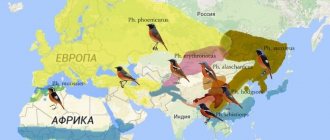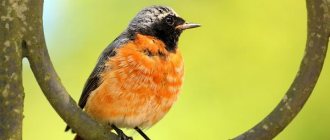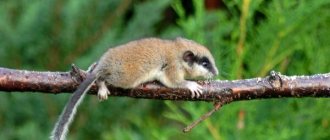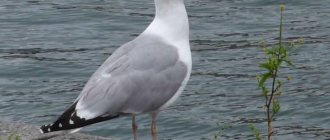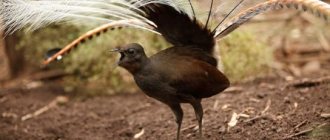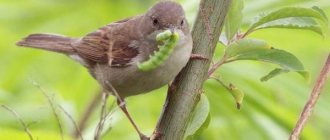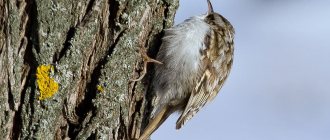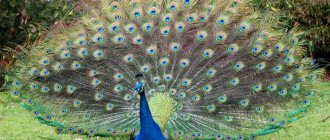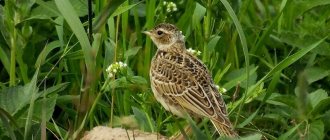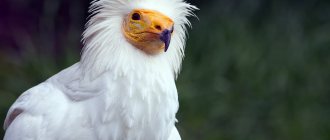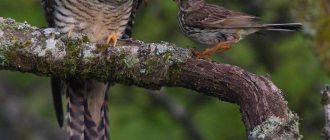Appearance of black redstart
The black redstart is similar in size to a house sparrow. Body weight 11 – 20 g, wingspan 23 – 26 cm, body length 13 – 14.5 cm.
Relatively short legs are painted black. The beak, wide at the base, is black and brown in color. The tail is colored red with a dark stripe in the middle, and the rump is bright red. Thanks to this coloring the bird got its name “redstart”. The rest of the body color of males and females is noticeably different. The coloration of the chest and upper body of males is dominated by dark tones. Their back is dark gray and the top of their head is ash gray. Representatives of the Asian population have a red belly, while birds living in Europe have a light gray belly.
Also, European males have a clear white spot on the wing. Female nigella are very similar to females of the common redstart, but they do not have reddish tints on the sides and chest. The body of females is brownish-gray and more uniformly colored compared to males. Juveniles are very similar in appearance to the female. In females, like in males, the iris of the eye is dark brown.
Black redstart (Phoenicurus ochruros).
Description and features
The size of the bird is comparable to the size of the familiar sparrow, 10-16 cm. The mass of the individual is approximately 18-20 grams. The bird's wingspan is up to 25 cm. The legs are thin and high. The small bird cannot be missed thanks to the bright color of its belly and tail feathers.
The fiery orange color gave the birds their name. The redstart in the photo shows that it cannot be confused with anyone else. The head and back are gray. Cheeks and throat are black. The female has a brownish color with red markings - less striking than the male. Juveniles have gray plumage with buffy spots. By autumn, the color of all birds fades and becomes muted.
The bird has a wide beak, slightly elongated. It is perfectly adapted for catching prey. A peculiarity of the redstart's movement is the frequent twitching of its unusual tail.
Migrating birds head to Central Africa for the winter in early autumn. They always fly away at night in September - early October. In the spring, in March–April, they return to their native nesting places.
Attempts to keep birds in cages are successful if they are well cared for. But it takes a long time for the redstart to get used to humans, and in captivity it sings little. At first, the birds' wings are tied up, otherwise they will hit the cage and die.
Habitat of the black redstart
In nature, nigella nesting sites are located in the highlands of northwestern Africa and Eurasia.
The eastern border of the range is level 111° E. in Central China in the northern part of the Ordos desert plateau. Nesting grounds located to the west and north of this region are mainly associated with the mountain systems of Southern Siberia, South-Eastern Kazakhstan and Mongolia. These are mountain ranges such as Khangai, Altai, Tien Shan, Western Sayan, Ulytau and Dzungarian Alatau.
In the Irtysh valley, the black redstart nests at a level of 51° N. sh., on the Yenisei to the level of 52° N. w. The southeastern limit of distribution passes through the Hindu Kush, the southern slopes of the Himalayas, southeastern Tibet and the Sino-Tibetan mountains. The nigella does not live in the steppe, lowland and desert regions of Turkmenistan and Uzbekistan, but to the west of these territories it appears again on the slopes of Elbrus, Kopetdag and in the Greater Caucasus mountains. In southern Iran, a small population of these birds has been recorded in the Zagros Mountains.
The black redstart is capable of hovering in the air for some time, like a hummingbird.
In Europe, the black redstart has spread far beyond the mountain ranges. Now she lives in southern Sweden, Latvia, southern England, and southwestern Finland. Breeding birds were noted in the Poltava region on the left bank of the Dnieper River. Despite this distribution, the density of mountain populations is much higher than that of plains.
Spreading
The black redstart (Phoenicurus ochruros) is distributed in Europe, northwestern Africa and central Asia. Once an inhabitant of exclusively highlands, starting from about the middle of the 17th century, it often settles far beyond the boundaries of the original natural range, including near human habitation. On the territory of Russia there are 3 isolated areas of distribution: the mountainous regions of Southern Siberia, the Greater Caucasus, as well as the plains of the western part of the European part, where the bird began nesting relatively recently.
Habitats of black redstarts
The habitats of this bird species are very diverse. Within the Western Palaearctic, the black redstart is the only species that lives in all geographical zones, from alpine meadows to sea level. This bird does not live only above the snow line. Nigella thrives both in populated areas and in mountainous areas with humid and dry climates.
In nature, the bird prefers open spaces free from dense vegetation. The terrain usually contains rocky outcrops, or brick or stone buildings replacing them.
The redstart feeds on small invertebrates, which it catches on the ground and in flight, as well as their larvae and berries.
The bird makes nests and perches on stones and buildings. Birds gravitate towards such open spaces throughout most of the year. Birds living in the city begin to visit nearby agricultural lands in the second half of the year. They especially love corn fields and fallow lands. Nigella avoids dense thickets of reeds, even despite the abundance of insects and other food in these places.
Redstart - a small bird with a red tail
Many people know a small black bird with a bright red tail, which it constantly swings, living in gardens and parks. For its bright tail, noticeable from afar, it received the name redstart. And if the males of this bird are very noticeable - they are dark, and the tail is bright red, then the females and young birds are not so conspicuous. They are brownish-gray in color, with a lighter belly and throat. But they also have a characteristic distinguishing feature - a red, swaying tail.
First, a short video with the characteristic cry (not song!) of a redstart. He sits on a branch swaying from the wind, shaking his tail and emitting a characteristic cry - “fuit-tick-tick-tick”:
The most famous and widespread in our country is the common redstart (also known as the garden redstart, the bald redstart). This small bird, smaller than a sparrow, is a bird of the flycatcher family with a bright red tail, which it often twitches. As a result, the red spot becomes clearly visible against the background of the bird’s gray back and brown wings and resembles a flaring coal. Other external characteristics of this bird: males have red entire underparts, the sides of the head and throat are black, and the forehead is white (hence the name coot). Females are light brown, darker above, with brown wings. Juveniles are brown with dark streaks. The main identifying mark - an orange-red tail - is present in both males, females, and young birds.
The red, “burning” tail of the bird became the reason for its Russian name. The fiery tail was also noted by Carl Linnaeus, who in 1758 described the redstart under the Latin name Phoenicurus phoenicurus, which can be translated as “Phoenix tail”. Phoenix, we recall, according to ancient legend, burned in fire and was reborn again, and the Greek word οὐρά means tail.
In English, the redstart is called redstart. The word start in this case goes back to Middle English stert and Old English steort "tail". It has nothing to do with the word start, meaning “to begin” (from the Old English styrtan “to jump up”). The red tail of the bird caught the eye of other peoples. Therefore, in many languages, the name redstart means “red tail” (Italian codirosso, Swedish rödstjärt, Greek κοκκινούρης, Danish rødstjert, Belarusian orestart). In Spanish, the redstart also has a name, abanico, which literally means “fan.” Apparently, the attentive Spaniards noticed how the male redstart periodically opens its tail, like a fan. The Finnish name for the redstart is leppälintu "alder bird". The Romanians call it codraş, which can be translated as “forester”, but they also know the name coadă-roşie “red tail”.
The redstart lives in deciduous forests, often in gardens and parks. She makes nests in hollows, stumps, and sometimes even on the ground under bushes. The redstart also settles in niches of human buildings, even in woodpiles. Usually the redstart stays low, on tree branches, on bushes, and flies to the ground, where it looks for food. However, a singing male can also occupy a place at the top of a tree.
An expert in bird song, Ivan Shamov, wrote about the redstart: “In April, as soon as the gardens begin to dry out after the spring thaw, the redstart is already here, flying from distant countries to its nesting places, year after year finding its corner without error, and from an early in the morning, as soon as a strip of light appears in the east, the bird fills the garden with its modest, characteristic song; in the month of May her song does not stop even at night. To the ear it seems to come out with the words: fi! re-re-re-re, bloom-bloom!... this is invariably repeated in one plane, but it is remarkable that the redstart almost never puts the same ending in its song, but every time a new one. And this makes the bird very entertaining; you always listen with pleasure and try to figure out what the ending will be. Usually it consists of the calls of different birds. In addition to this song of the redstart, the reader has undoubtedly heard its characteristic call: howl! whit!, which she repeats loudly and for a long time, especially before bad weather, and when she is worried about something, she shouts: whit-te-tek! (“Our Songbirds”, 1910).
People are accustomed to hearing meaningful words and phrases in the singing and cries of many birds. For example, it was believed that the lapwing asks: “Whose are you?” whose are you?”, and the lentil: “Did you see Vitya? Have you seen Nikita?” The singing of the redstart has not escaped this popular interpretation. The peasants of the Smolensk province believed that the redstart was boasting: “I was in St. Petersburg, I was in St. Petersburg... I saw Peter, I saw Peter.”
The redstart feeds on insects. The bird looks for them on the ground and on branches, and can catch them in flight. Ornithologist A. N. Promptov calculated in 1940 that a redstart feeding chicks brought food to the nest 469 times per day. Redstarts hunt both flying insects and caterpillars. The diameter of the hunting area reaches 200 - 300 meters. At the end of summer, the redstart adds berries to its diet.
The summer home of the common redstart can be in large gardens, at the edge of the forest, or in fields. These birds make nests in the hollows of old trees. Common redstarts most often feed their chicks with insect pests, which is why gardeners and gardeners love them so much.
Pairs of redstarts often persist for several years. Males return to nesting sites earlier than females. They are looking for a place for a nest: usually it is a hollow or a pile of dead wood. Having found a place, they invite females without moving away from the site: after all, they can take the place. There is another way to attract a female - climb into a hollow and stick out your “flaming” tail. The female looks for a male and flies into the hollow. After the appearance of a partner, the male immediately begins mating games. When the female approaches the future nest, the male begins to sing a song and bows his head, showing his white forehead, and spins around his axis. After this, the birds mate and together line the hollow with dry grass, bark and moss. At the final stage, the “children’s room” is insulated with down and wool. The female lays 6-7 eggs and incubates them for two weeks, leaving the nest from time to time to satisfy her hunger. Both birds bring food to the chicks that hatch two weeks later.
The male redstart's responsibilities also include keeping the nest clean during the first days after the chicks hatch. The male carries baby excrement out in his beak. 2 weeks after birth, the chicks learn to fly. However, even when the female incubates the second clutch, the male continues to care for the chicks from the first brood. After the birth of chicks from the second clutch, the older chicks begin an independent life.
In Europe, the redstart lives in light mixed forests, and in Africa and Asia Minor it also inhabits mountain forests. She leaves rocky places and rocks near mountain meadows to a close relative - the black redstart.
In some gardens both species of these birds coexist. Among the redstart's favorite places to live are old parks and alleys, where there are many old hollow trees. In Berlin, redstarts have colonized city parks, gardens and cemeteries. Nowadays, urban populations of redstarts exceed those in suburban forests. At the end of August, redstarts begin to prepare to fly to warm Africa. The winter is spent in countries located south of the Sahara.
Redstarts feed on a variety of insects and spiders, which they find on the ground, on tree trunks, branches and leaves. Occasionally, birds catch insects in the air, looking for prey from ambush.
The redstart is in no hurry to eat the caught prey - first it takes it to a safe place. It stuns large insects, such as beetles, in advance by hitting the ground, and tears off the legs of grasshoppers. In addition to caterpillars, ants, small mollusks and centipedes, the bird eats berries and fruits. Small chicks are able to swallow only crushed food, so adult birds first crush the caught insects and only then give them to the chicks.
Gluttonous chicks often bring their parents to complete physical exhaustion, because the birds fly to the nest up to 500 times a day, each time bringing food to the chicks in their beaks.
The redstart often nests next to a nuthatch or tit. She willingly lays eggs in specially prepared nesting houses. The higher its house is located in the garden, the greater the chances of successful breeding of the bird, of course, provided that there is a sufficient amount of food in the area. Gardeners rejoice when these insectivorous birds appear in their gardens. The “friendship” of people with the redstart brings them great benefits. After all, the bird rids gardens of various insect pests: grasshopper beetles, bedbugs, caterpillars, leaf beetles and mosquitoes.
Interesting facts about redstarts:
- Redstarts, like wagtails, swing their tails up and down.
- The common redstart can attack its reflection when it sees it, for example, in the glass of a window.
- The male hunts prey in flight, while the female looks for food on the surface of the ground.
- The name of this bird indicates that it has a brightly colored tail. It “burns”, because the tail feathers are fiery in color.
- It is in the redstart's nest that the cuckoo most often leaves its eggs. Redstarts care for cuckoo chicks as if they were their own chicks.
There are several more representatives of the redstart genus on the territory of Russia. The Siberian redstart (Phoenicurus auroreus) lives in eastern Siberia. In the Altai, Sayan and Tien Shan mountains there are grey-headed redstart (Phoenicurus caeruleocephala), red-backed redstart (Phoenicurus erythronotus) and red-bellied redstart (Phoenicurus erythrogastrus). The last of these species can also be found in the Caucasus.
Diet of the black redstart
The diet is based on various insects and other small invertebrates. In autumn and summer, plant foods, especially berries, are added to this menu. Insects from more than 50 families become prey for nigella. These are various arthropods, snails, arachnids and other animals living on the surface of the earth. Redstart prey typically range in body size from 2 to 8 millimeters. However, sometimes birds eat earthworms and caterpillars, the body length of which can reach 7 cm. Before feasting on such large prey, the nigella tears it into smaller pieces.
The most noticeable identifying feature that gives the bird its name is its bright rufous rump and tail, which twitches constantly.
When hunting on the surface of the earth, the redstart waits for the victim on some hill in the landscape: a rock, the ridge of a roof, a stone, a branch. As soon as the intended prey is found, the bird quickly dives down, grabs the victim with its beak, and takes off with lightning speed. In addition to this method, the nigella often resorts to hunting on the fly. It should be noted that the hunting methods, as well as the diet of the black redstart, are very diverse. In this matter, the bird is very versatile and is able to adapt even to very strong changes in the food supply.
OBSERVATIONS OF THE REDstart
The redstart often nests next to a nuthatch or tit. She willingly lays eggs in specially prepared nesting houses. The higher its house is located in the garden, the greater the chances of successful breeding of the bird, of course, provided that there is a sufficient amount of food in the area. Gardeners rejoice when these insectivorous birds appear in their gardens. The “friendship” of people with the redstart brings them great benefits. After all, the bird rids gardens of various insect pests: grasshopper beetles, bedbugs, caterpillars, leaf beetles and mosquitoes.
Reproduction of black redstarts
Sexual maturity in birds comes with the end of the first year of existence. As a rule, nigella are monogamous, but sometimes one male can have two females. Males arrive at the nesting sites first, and females arrive within a few days to two weeks after them. By the time the females arrive, each of the males already has their own protected nesting area.
The male marks the territory of the future nest by sitting on a raised platform and singing. The size of the nesting area can range from 0.35 to 7 hectares. When a rival male appears on the nesting site, the bird emits a piercing cry, flies close to the enemy and sometimes even attacks him.
In the first ten days, the chicks increase in weight by more than 10 times, and 11 days after birth they develop plumage.
The nest is usually open or half hidden. Within populated areas, the nest is erected on a variety of buildings. In the mountains, the nest is located in cracks, among a scattering of stones, in a rocky recess or on a cornice. The Nigella redstart nest is a fairly large cup-shaped structure. The building material for it is mainly the long stems of last year's grass.
The interior decoration of the nest consists of roots, moss, lichen, cotton wool, paper and tow. The bottom is lined with feathers and wool. The male and female take part equally in the construction of the home. Sometimes a ready-made nest from last year is used for housing.
Listen to the voice of the black redstart
In good weather, the nigella spends about 6 hours a day singing, repeating the same verse with variations up to 5000 times.
In Central Europe, birds lay from 2 to 3 clutches per season. The first clutch is usually the largest and contains from 4 to 7 eggs (average 5). In repeated clutches, the number of eggs, as a rule, does not exceed 4. The shells of eggs are often painted snow-white, sometimes with a bluish tint. The female begins incubation after laying the first egg. The incubation period lasts about 12 to 17 days. At this time, the male flies away from the nest and does not appear in it.
Chicks hatch from eggs within just a few hours of each other. Both parents take part in the process of courting and feeding the chicks. In the first 10 days of life, the weight of the chicks increases 10 times. At the age of 10 days, the first feathers begin to appear on the chicks. After 13 - 19 days, the chicks are already able to fly tolerably, but they live in the nest for about 2 more weeks, after which they fly out of it and never return, starting an independent life.
If you find an error, please select a piece of text and press Ctrl+Enter.
WHAT DOES IT EAT?
Redstarts feed on a variety of insects and spiders, which they find on the ground, on tree trunks, branches and leaves. Occasionally, birds catch insects in the air, looking for prey from ambush.
The redstart is in no hurry to eat the caught prey - first it takes it to a safe place. It stuns large insects, such as beetles, in advance by hitting the ground, and tears off the legs of grasshoppers. In addition to caterpillars, ants, small mollusks and centipedes, the bird eats berries and fruits. Small chicks are able to swallow only crushed food, so adult birds first crush the caught insects and only then give them to the chicks.
Gluttonous chicks often bring their parents to complete physical exhaustion, because the birds fly to the nest up to 500 times a day, each time bringing food to the chicks in their beaks.
